

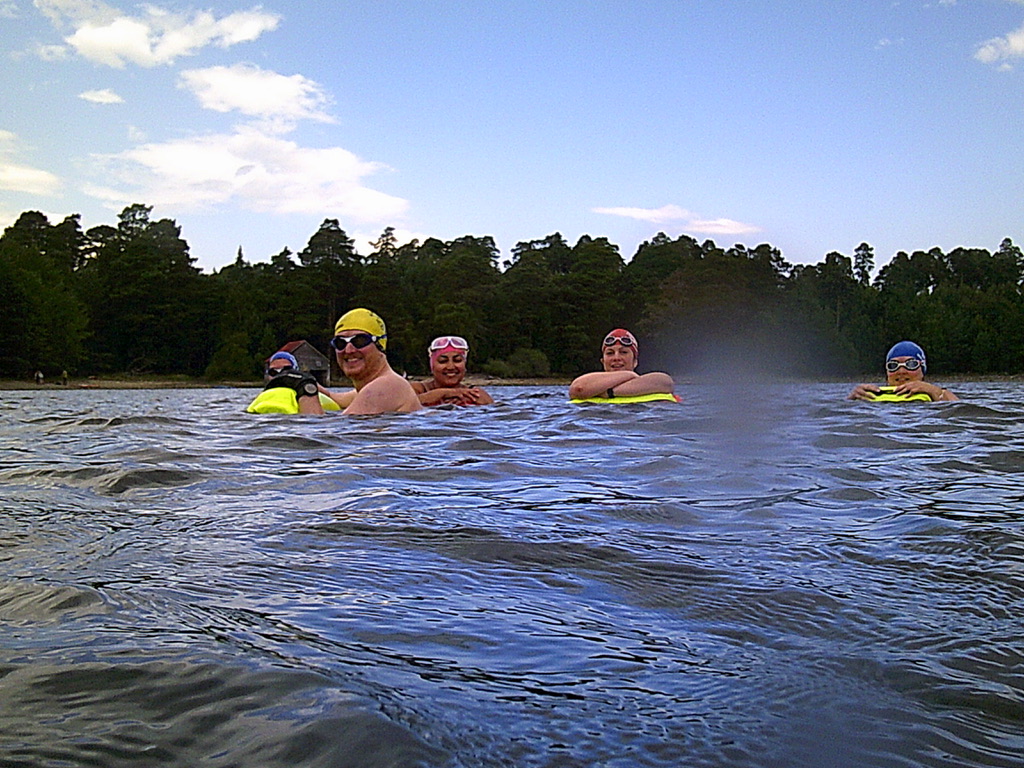

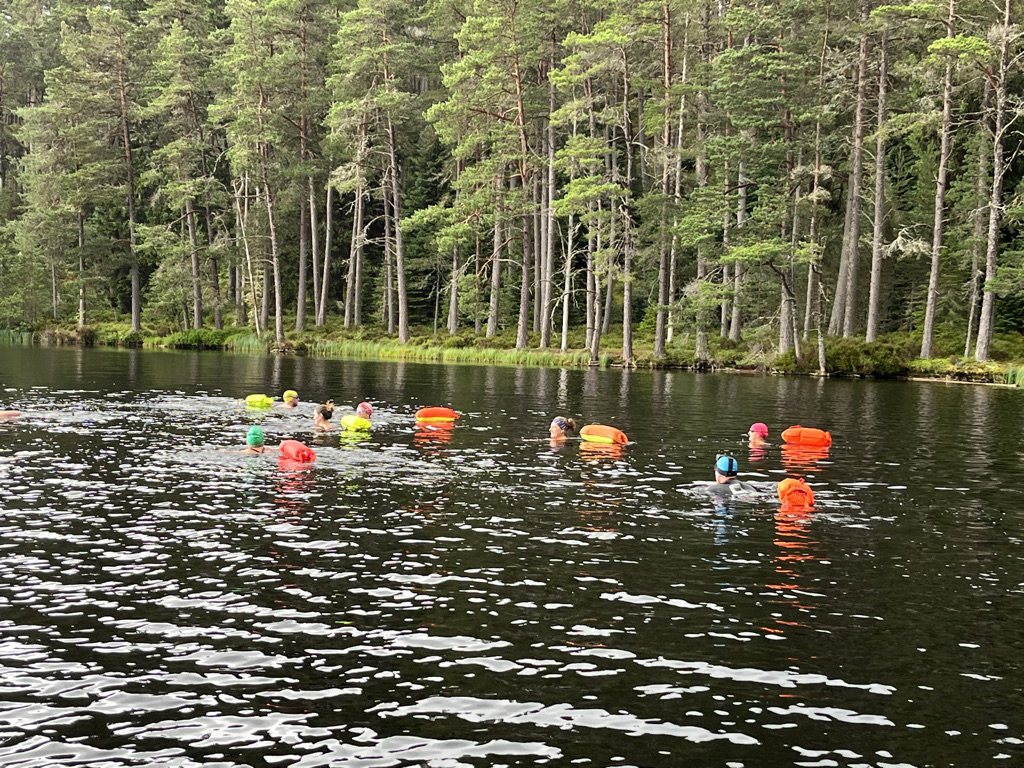
The second members Swim Weekend, on Speyside, was just as wonderful as the Bute Weekend. We swam in a variety of locations, challenging our swimming senses and extending our range and experience of conditions. It was all about freshwater and not a jelly-fish in sight!!
Friday 7th July
Arriving with Gareth and Emma at the car park for Loch an Eilein, we find Barbara and Nigel are the first to have arrived, again – keen beans! It was a dark and brooding sky, the trees towered above us and a stiff breeze rustled the leaves. As Emma and Gareth sorted the paddle-board kit out, I had a quick march to the loch side to see how the wind was affecting the water conditions. There was little disturbance of the dark surface but nothing compared to our recent wave experiences at Groyn 5.

Loch an Eilein
The ruins were once a stronghold of the notorious “Wolf of Badenoch”
Dark peaty waters greeted us as we took a short walk up the side of the loch to the bank opposite the island ruins. The 13th Century structure is a landmark worthy of a visit if you are in the area. When we were children we used to stand and shout at the walls, to hear our echoes cascading back to us across the still waters. There is a beautiful circular walk and paths leading off to the surrounding hills and forest areas.
Entering the water is tricky here at the loch side, as you encounter an uneven surface with slippery stones underfoot. However, a helping hand and a useful tow-float to balance on, means that we all get in without incident. With Gareth leading and Emma out on the paddle-board we set out for the castle island. It is a short swim but there are a number of immediate challenges; the water is much cooler – just below the surface; the water immediately becomes deeper and darker; freshwater has less buoyancy than our familiar salty sea.
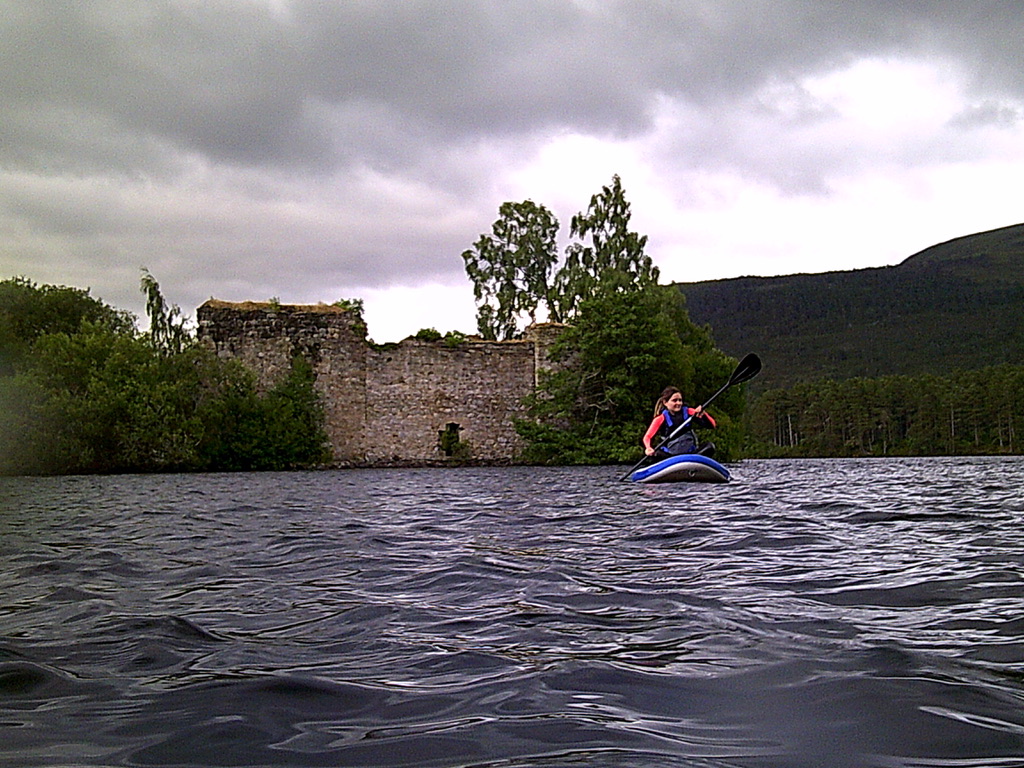

Nonetheless with our safety paddle-board already out on the water and a slow start, everyone was soon swimming with confidence to the castle island. Despite our best efforts, we could only locate the stones closest to the island which had previously formed the ancient causeway. Once we had achieved our crossing it was an unanimous decision to circumnavigate the island ruins. As we did so we were able to view the structure from all aspects and marvel as the light dwindled further and the dramatic effect of the greying skies was amplified.
Saturday 8th July
Today we started nice and early, meeting at the Feshiebridge Car Park at 0845 just as the sun was beginning to hit the rocks in the shallow pool area downstream from the bridge.
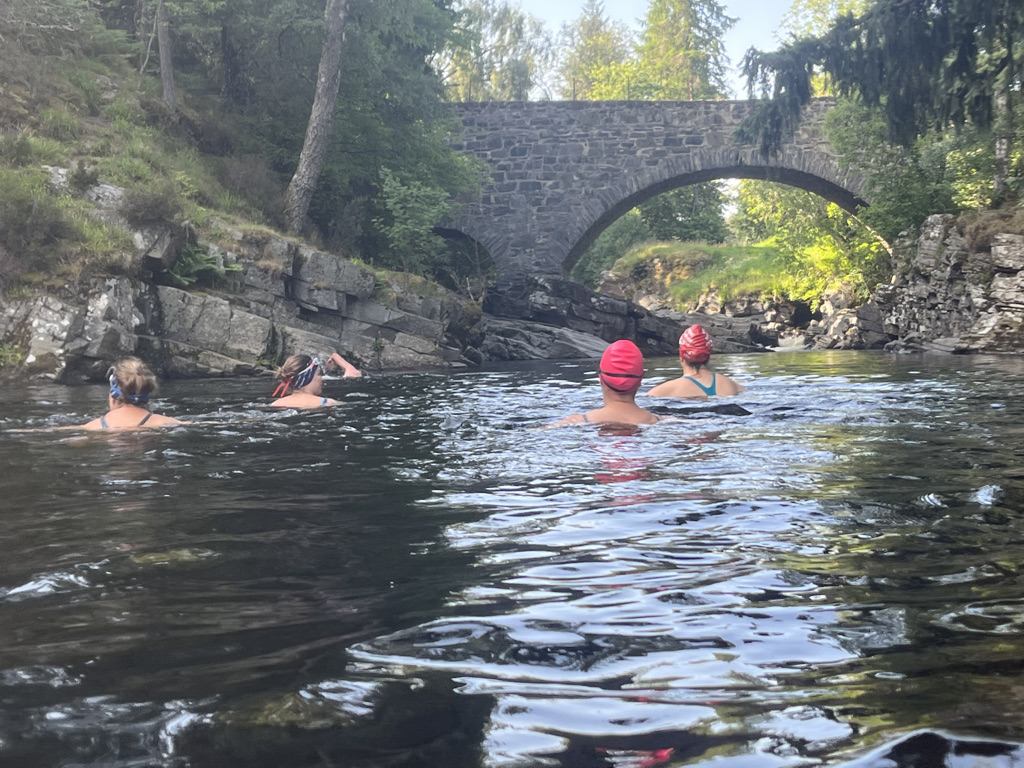
Feshiebridge
This bridge dates back to late 18th Century, and uses the natural rock formation to minimise the necessary span of the main arch across the river.
Golden waters await us as we approach the shallow pool below the bridge spanning the River Feshie. The stone and shingle that make up the base of this pool is glinting in the bright morning sunshine. The main pool, which is deeper but has some underwater rock formations, is shaded by the magnificent fir which over hangs the river, precariously balanced on the top of the rock face.
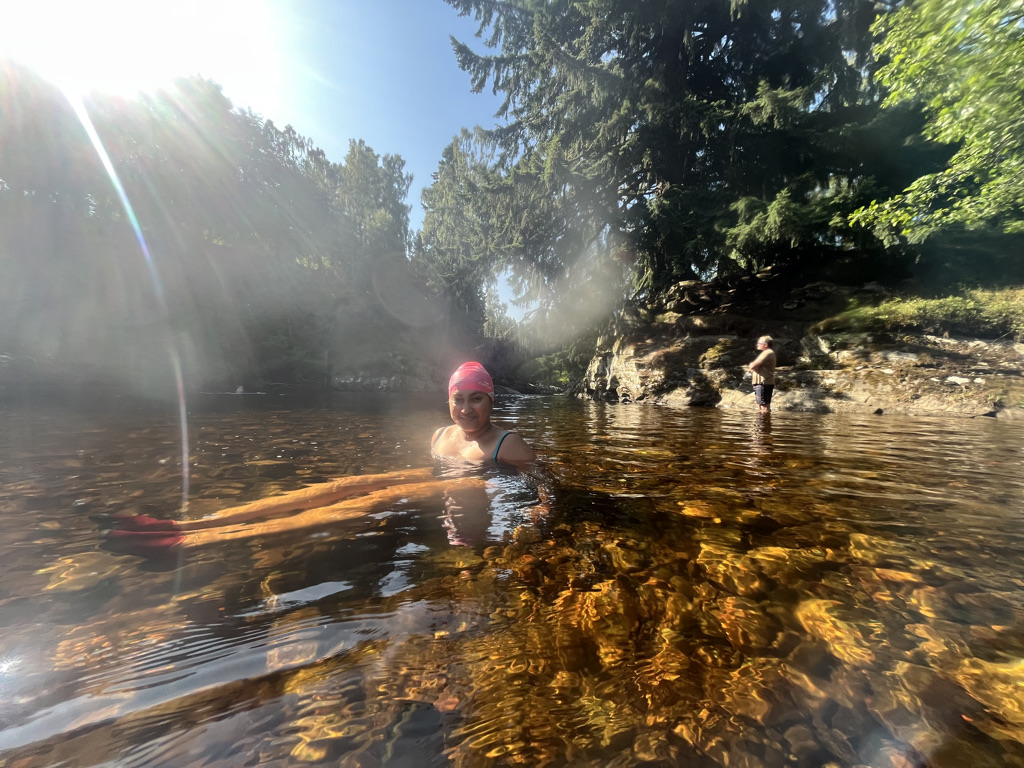

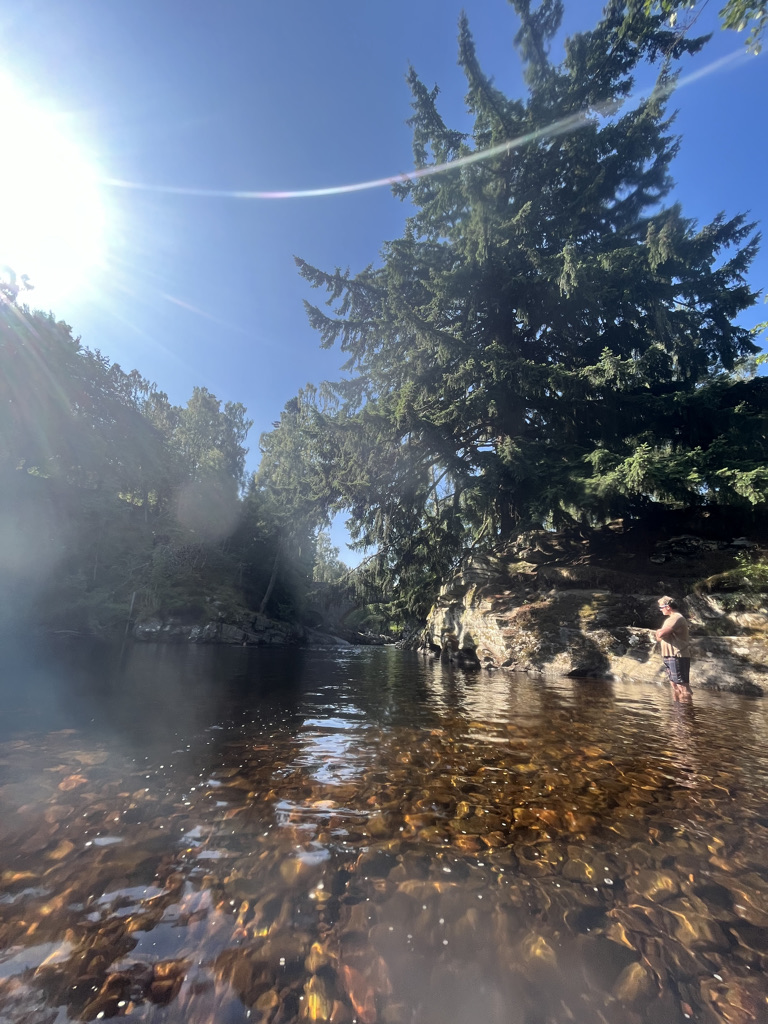
The water flows quickly as it shoots out of the narrow gorge below the bridge, the rocks below the surface, although smoothed by the force of the water over the years, are still solid if encountered. Before entering the water we go to the rock face and observe the flow and how it is being affected by the rock formations. Maree highlights areas of back flowing water, called eddys, where some assistance can be gained whilst travelling up stream against the current of the river. We note the positions of the most prominent underwater rock formations and head to the beach area to get ready for our swim.
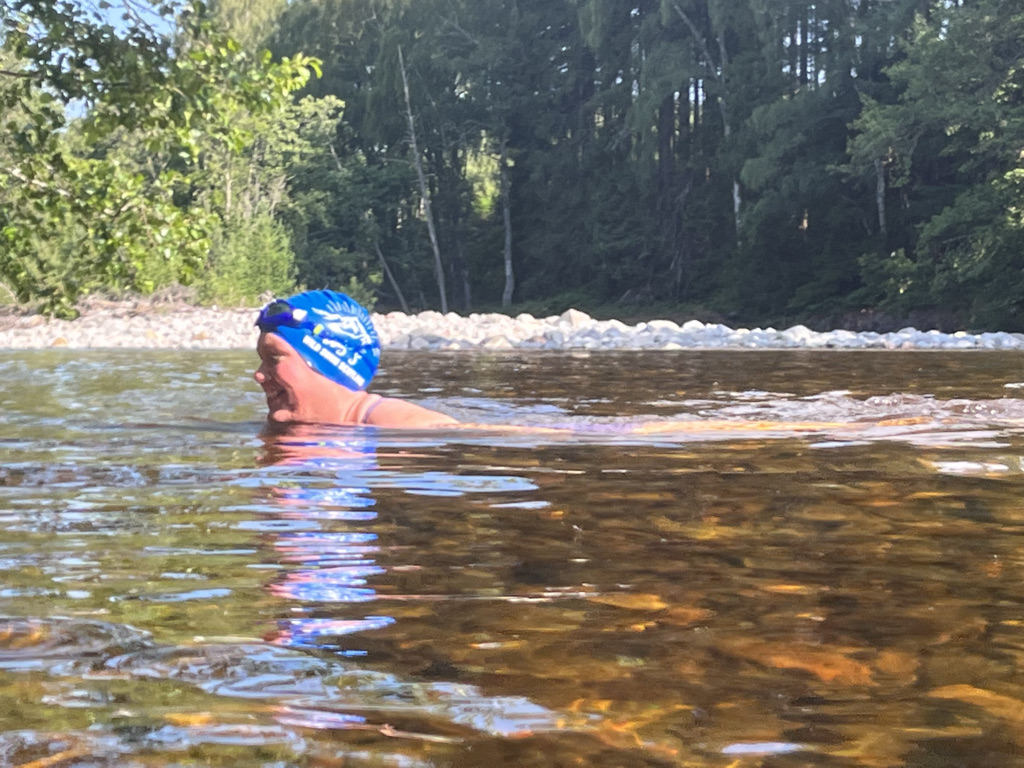
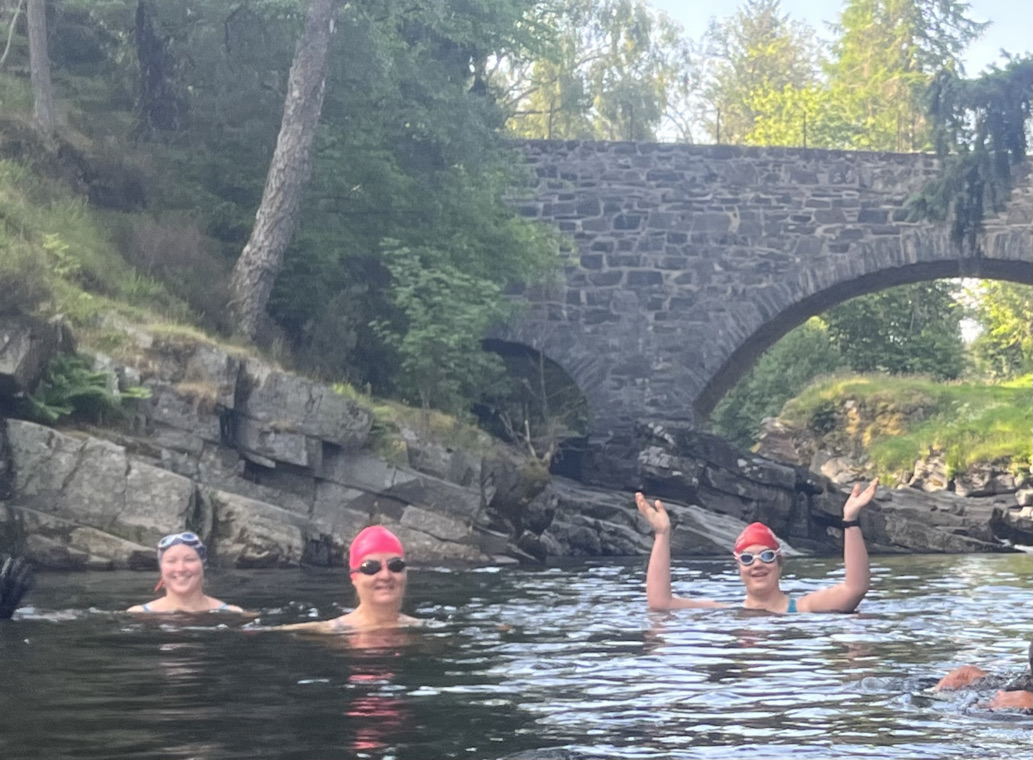
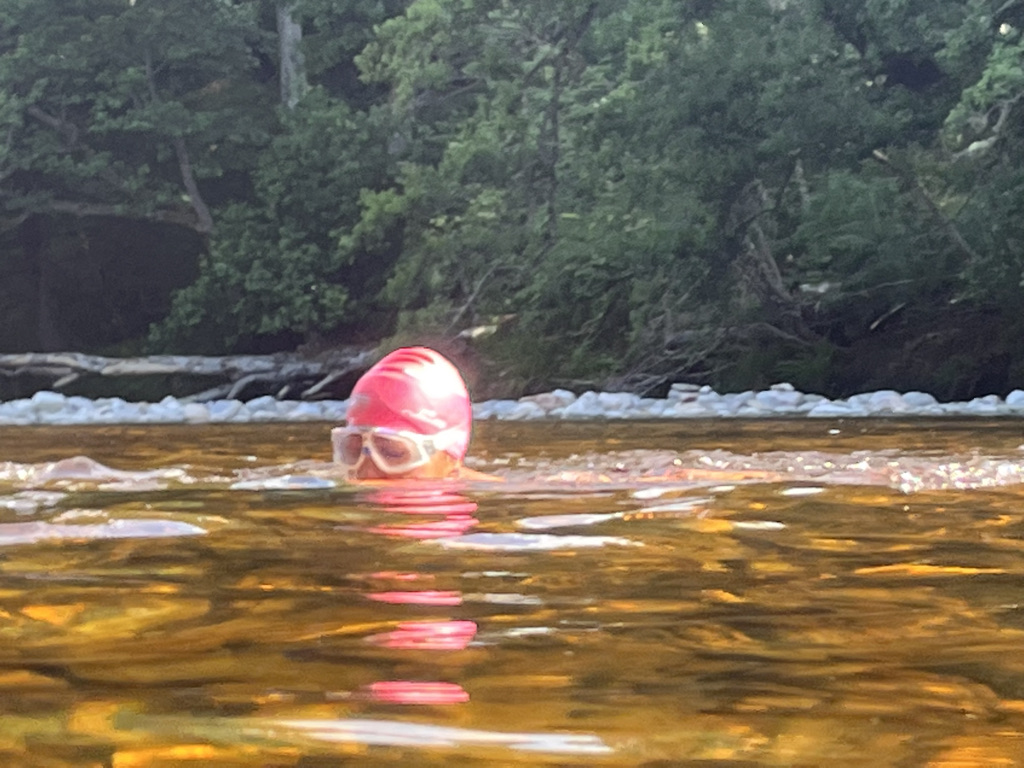
Entering the calm water over the shimmering stones and heading towards the deeper fast flowing water challenges our swim senses. We head up stream close to the far bank using the calmer eddy water to assist our progress. Sneaking in behind the prominent rocks we can peer at the tumbling waters as they descend beneath the bridge. As we exit from behind the rock we are quickly swept back to the calmer pool, over the low lying rocks. We quickly work out how best to avoid a knee bash and get a little circuit going. Once everyone has built up their confidence we climb onto the flat rocks and carefully pick our way down to the fastest flowing channel. Ashley is brave and takes the first shoot down the rapid, with everyone following on. There is one sticking out rock underwater as we exit and for a few turns Maree stays there is guide us away from it. It is an exhilarating experience but we are safe and risk only a few bumps and bruises from slips on wet rocks or knocks from the under water rocks.
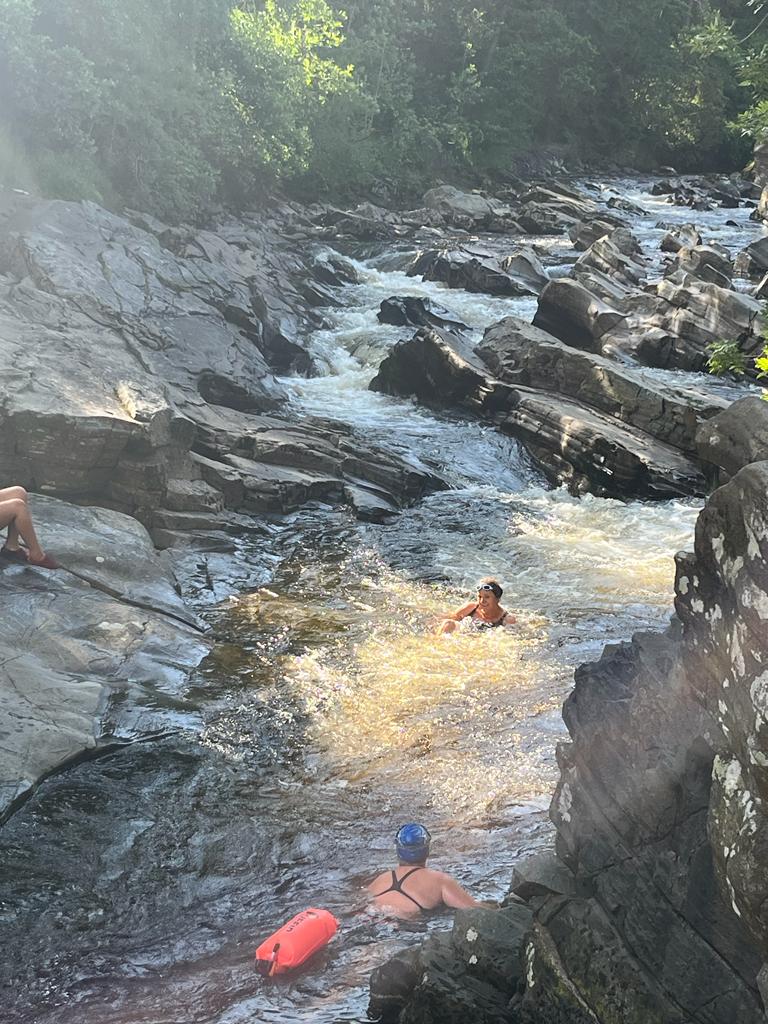


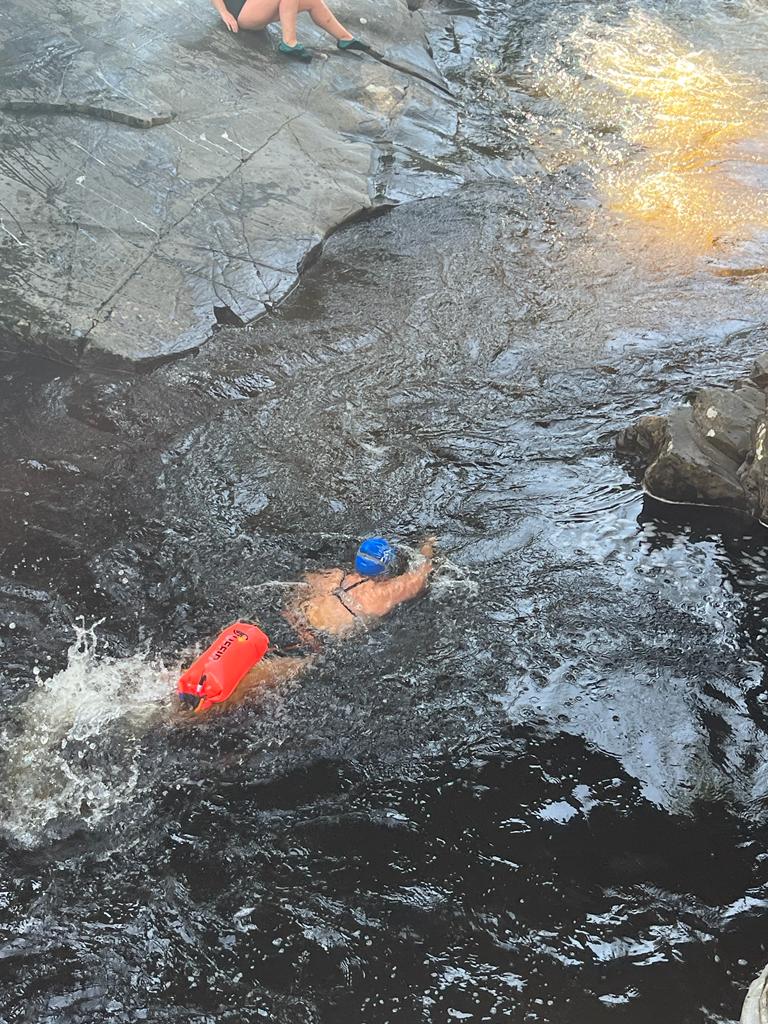
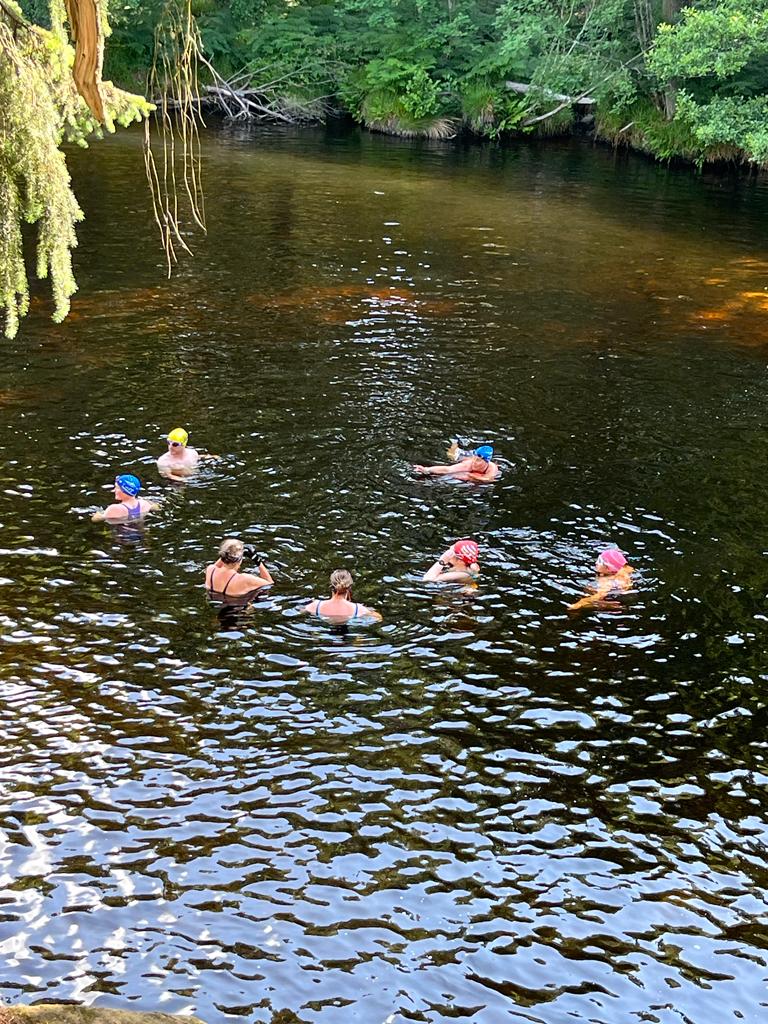
After our exciting swim in the shade of the trees we exit into the shimmering gold of the calm waters. With instructions where and when to meet next, the swimmers head off to grab some dry kit and I head to the bus station to pick Cli up, who has managed to organise herself onto the early bus and come for the day!!!!
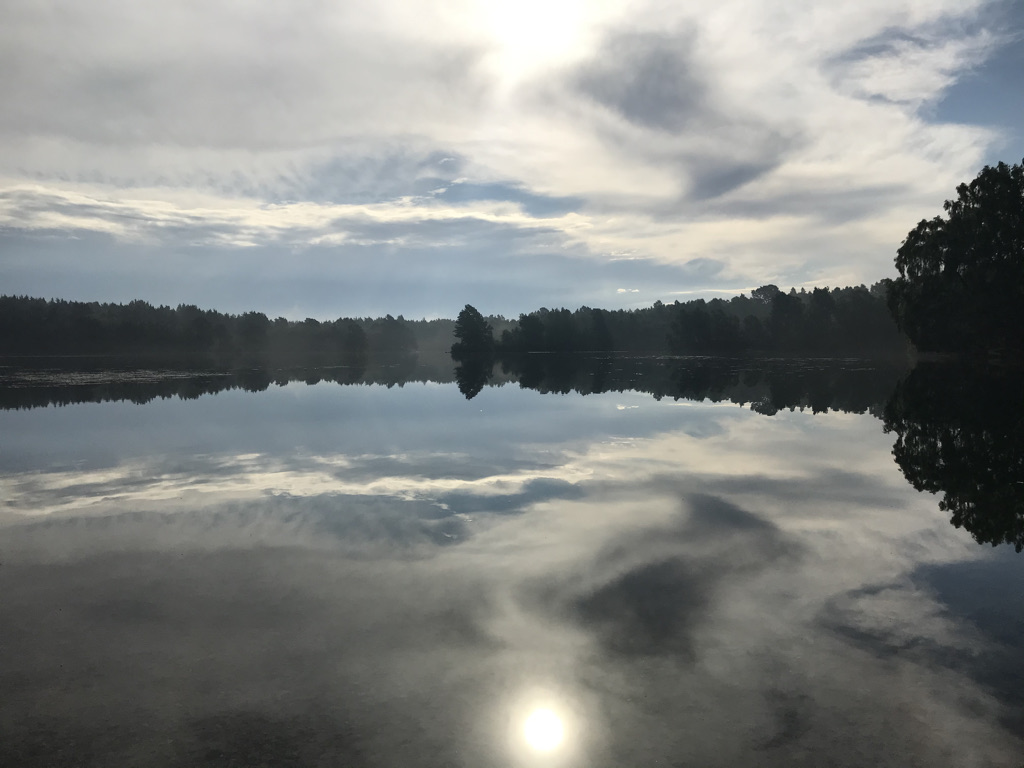
Loch Vaa
A beautiful loch close to Aviemore. Currently the crannog is in view. The water levels of this loch have fluctuated significantly over the last 5 years with no apparent obvious cause.
We decided to go for a shorter walk and a longer swim at Loch Vaa. This beautiful loch is accessed via a number of pathways and although there is a small carpark near Laggantygowan cemetry, it is regularly full. We did not want to take up all of the available parking so elected to park further away and walk in to the venue. We sent Emma on a head, with the paddle-board to choose us a good vantage spot. The walking around the loch side is under the trees lining the shore, over tree roots and up and over small hillocks. Care is required but there is plenty to hold onto to help keep you balanced as you adventure. Emma had selected us a sunny spot on the top of one of the hillocks with a great view of the loch (as well as a couple of ant hills!!!!)
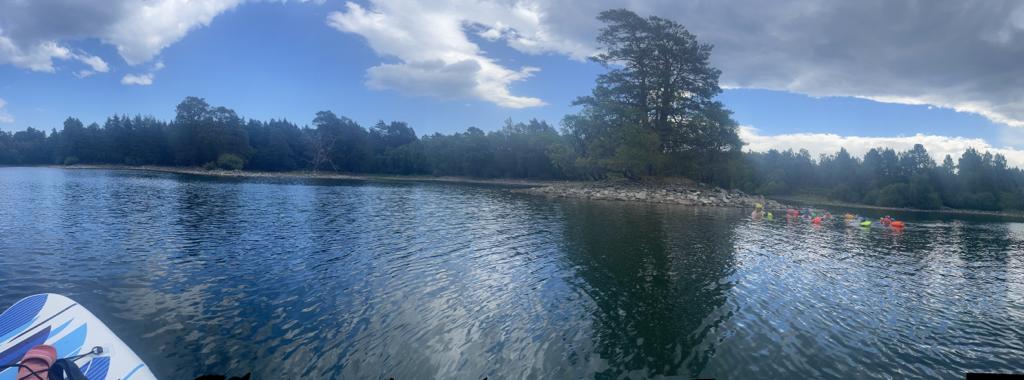
The water was greeny / blue in comparison to the darker waters we had already encountered over the weekend. Although it was windy the loch provided sheltered conditions. We swam around 1km from point to point in this sheltered loch, with Emma accompanying us. It was interesting for the swimmers to compare the lack of buoyancy levels in the freshwater on the effectiveness of their stroke. This again showing how much adaptability and acceptance is so much part of the experience of swimming outdoors.

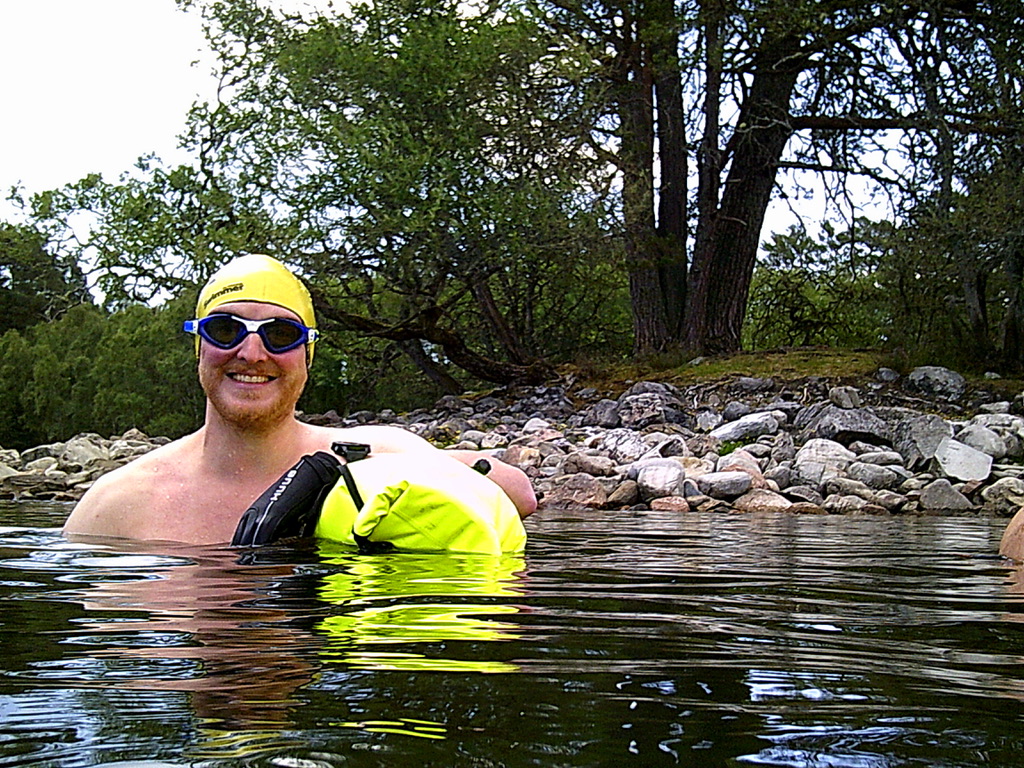

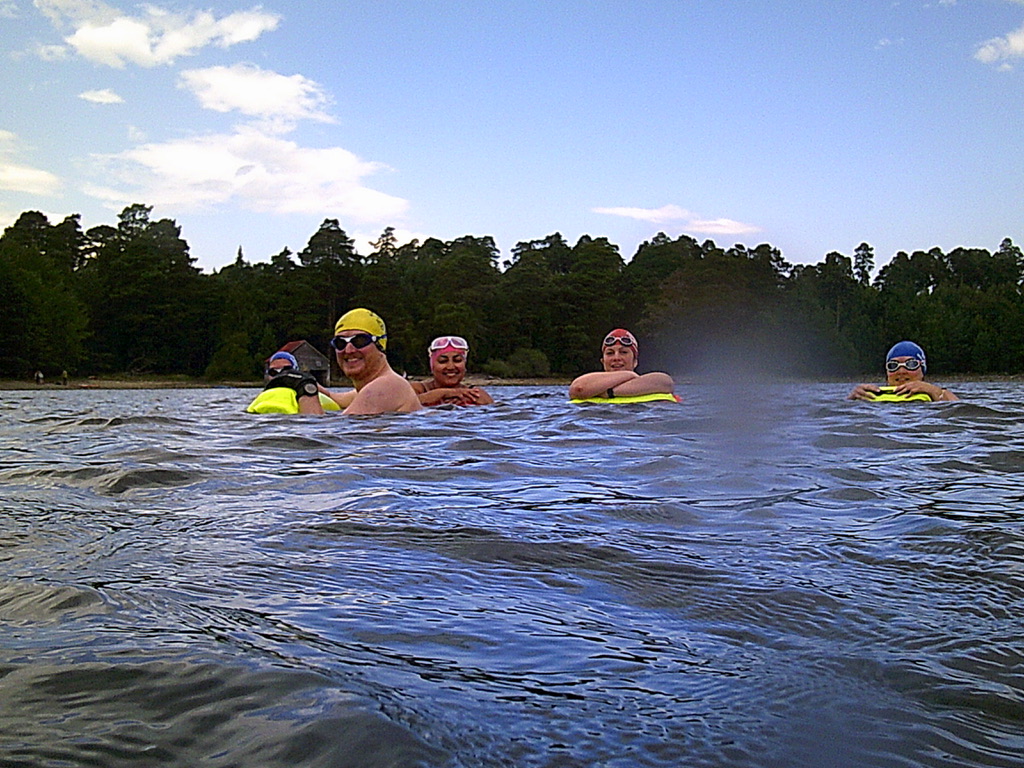
We had a sunny spot to enjoy our picnic lunch and a bit of relaxation in the sun, before walking back to the cars and arranging our final swim of the day.

River Spey
The River Spey flows from Loch Spey in the Corrieyairack Forest to the Moray Firth.
We met not far from Dalfaber, where some of the group were staying and walked to the banks of the Spey. This fast flowing river is Scotland’s 2nd longest river at 107 miles and flows from Loch Spey to the Moray Firth, through numerous villages. It snakes through Loch Insh Marshes, abundant with nature, Loch Insh itself where our friends The Freshwater Family have Loch Insh Watersports / Outdoor Centre. Speyside is obviously famous for it’s whisky and with the area providing more whisky distilleries than any other area of Scotkand, you can see why. There is a trail which follows the banks of the Spey, the Speyside Way which is a wonderful cycle or walk. I have yet to experience the Spirit of the Spey, which are canoe tours provided by David Craid, taking in disilleries and whisky tastings on the way, however, this is definitely on my “retirement” activity list!!
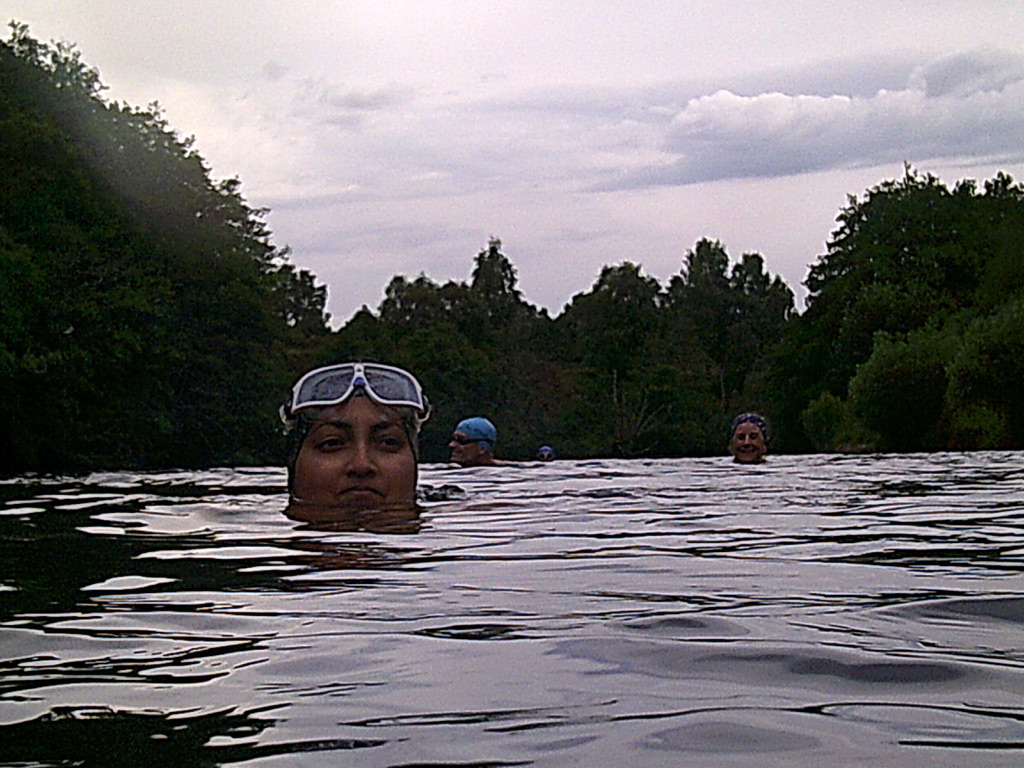
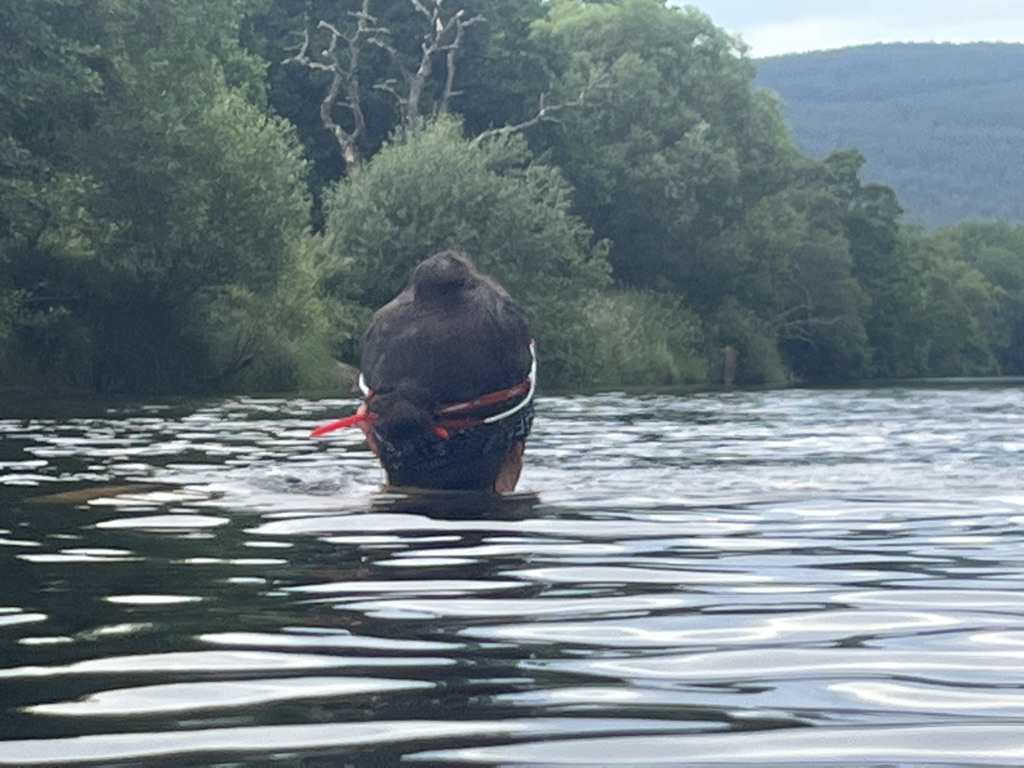

The Spey was indeed fast flowing as we entered at the small beach area, uncovered by the lower water levels. The Spey speeds up as it descends towards the sea, which is the opposite to most long rivers which tend to be faster at source and slow down to meander to the sea.
We had a play around in the shallows trying to swim against the flow of water, ferry-gliding our bodies diagonally across the stream to successfully navigate the water and reach a designated point on the bank. Maree had checked the banking above and below our entry point for fishermen. The Spey is also famous for it’s expensive salmon beats with permits costing in excess of £100, it was only fair to ensure we did not disturb anybody. However, the “coast” was clear and so we also walked up the bank a short distance and then floated down with the current a couple of times before heading to Spey Valley Golf Course for a sundowner!!!!
Sunday 9th July
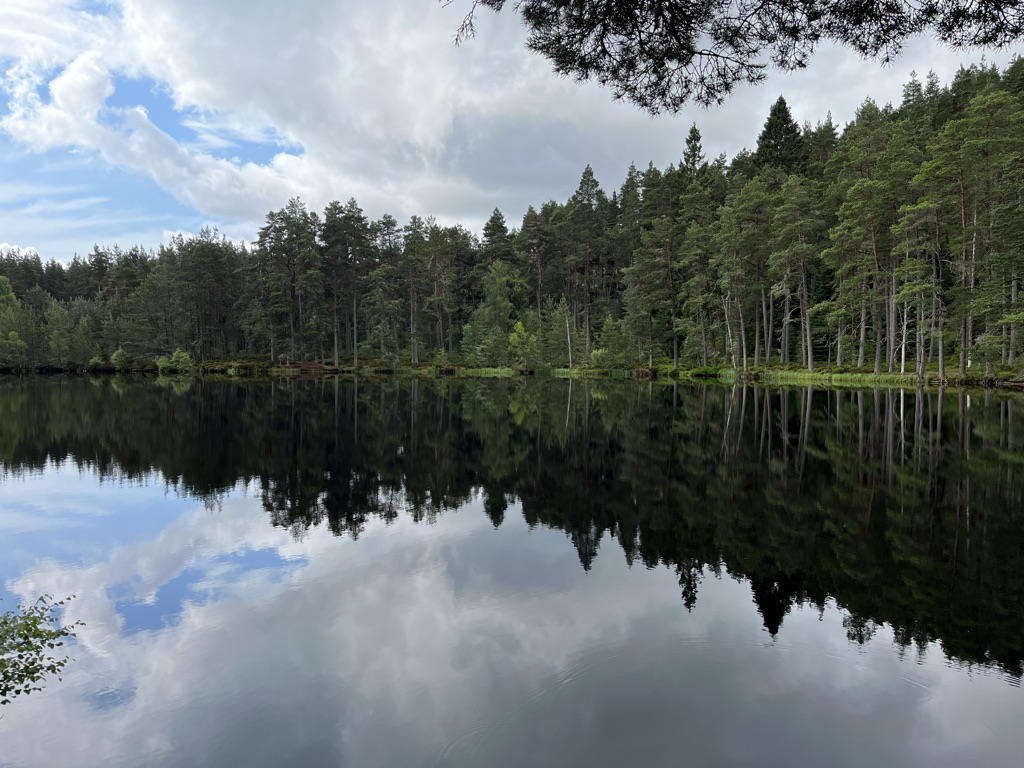
An Uath Lochans
This little group of lochans over looked from the crags were a favourite of ours as Childrens – “The Rock Cliff Ponds”
It had rained heavily overnight and Ashley and Conrad had only just stayed dry in their tent. Luckily our planned swim was at these beautiful, ancient lochans, which are not affected by run-off water from nearby agriculture. These lochans were created tens of thousands of years ago as the ice retreated, they are dark and peaty and spine tingly atmospheric. John D Burns describes them as “Tears of Ice”
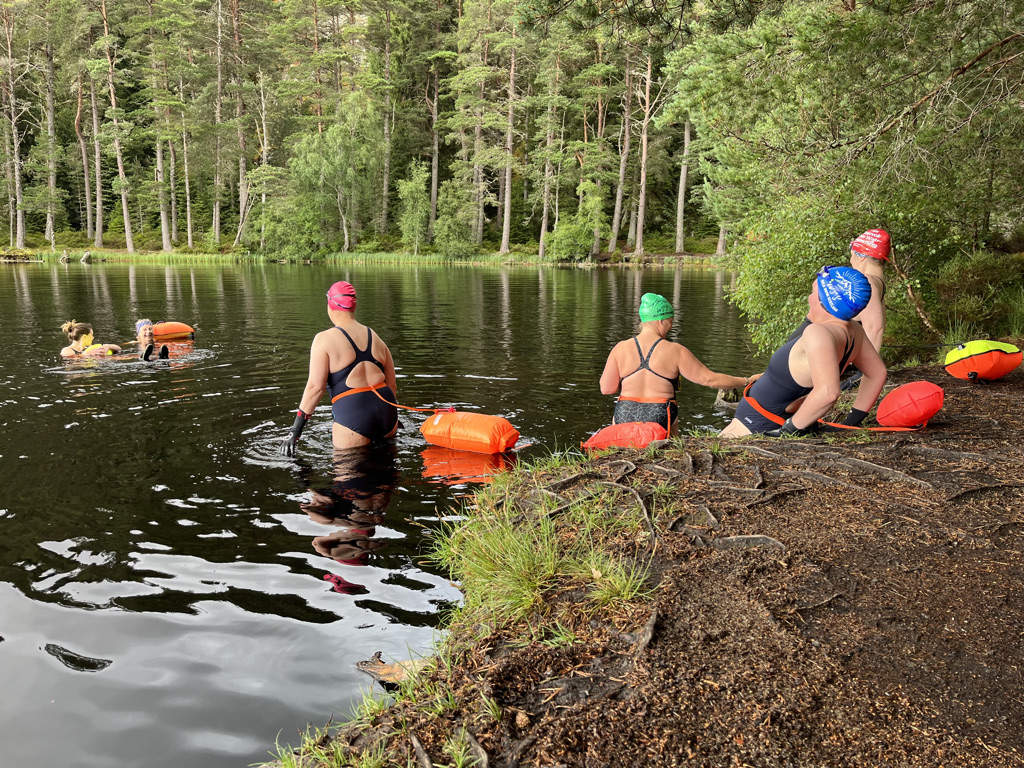

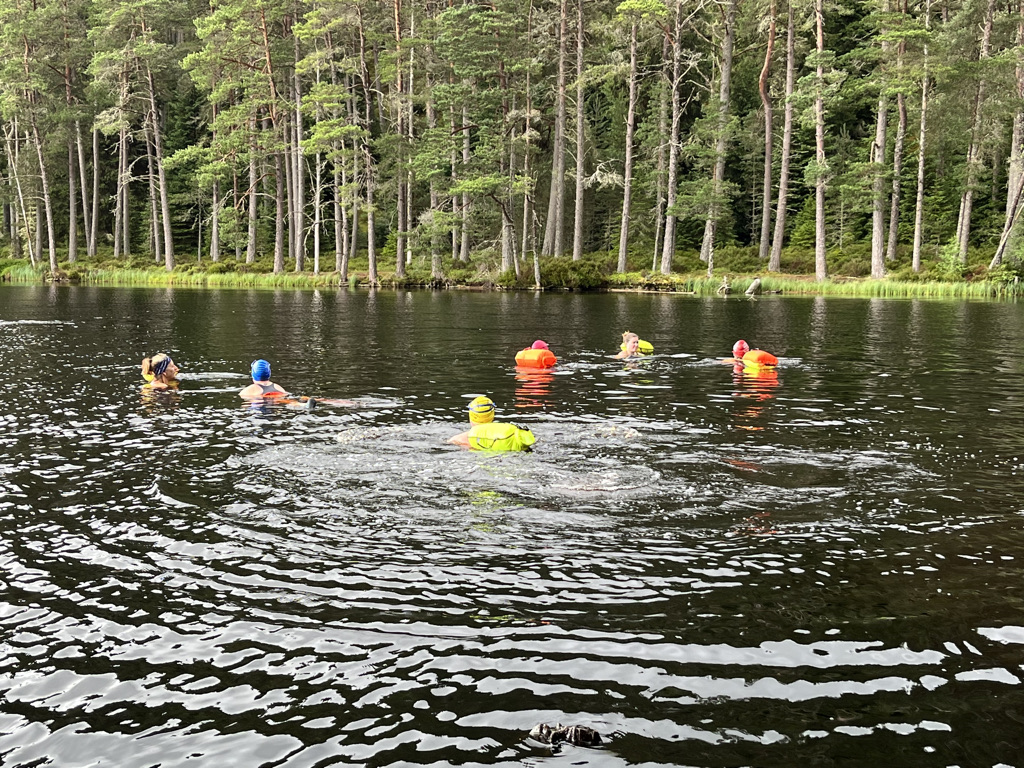
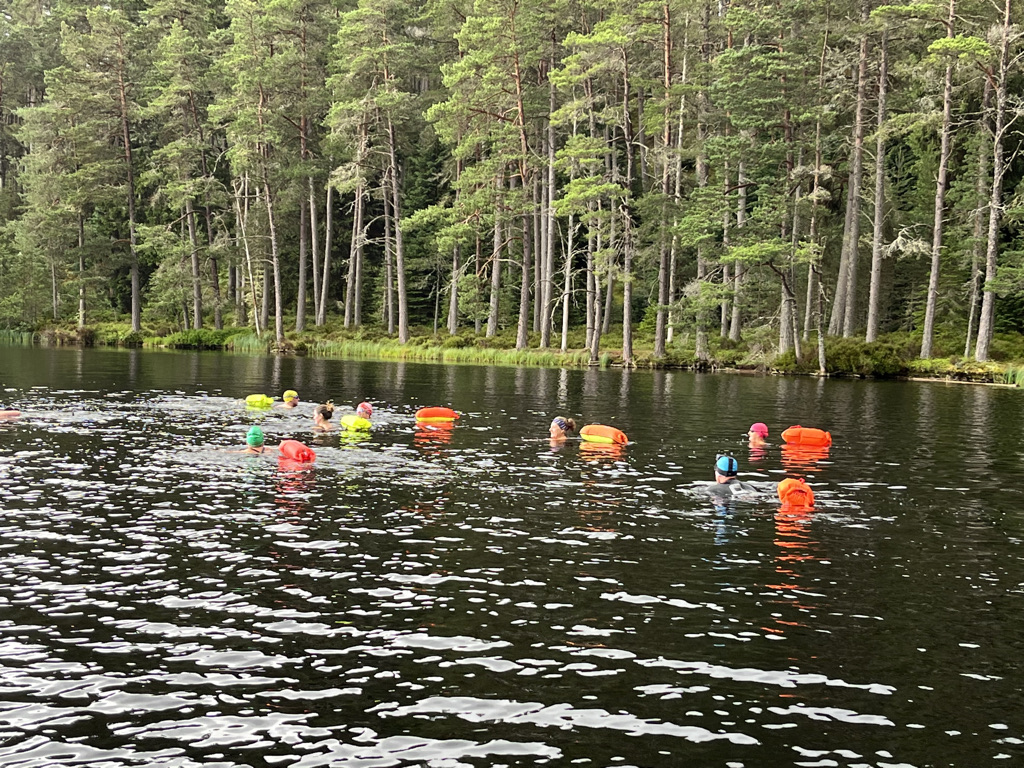
Not easy to access, this venue once again challenges the groups swimming senses. The water is so dark that you cannot see anything near the edge and trust is put in feeling your way into the water. Slipping carefully down from the delicate edge of the lochan, feeling for the tree roots, stones and pine needle base, slightly perturbing to say the least. However, once floating in the peaty blackness of the Uath Lochan we feel at one with landscape. Although we don’t look it, with our luminous hats and tow floats!!!!
It was a pleasure to introduce these loyal members to some of my favourite locations. Hopefully we can do it all again soon.